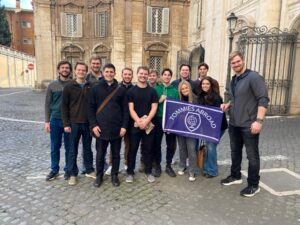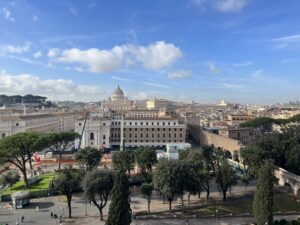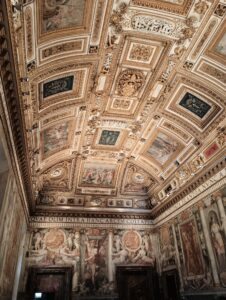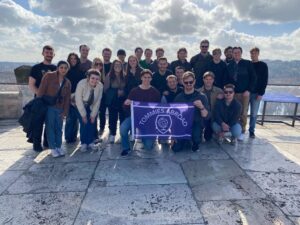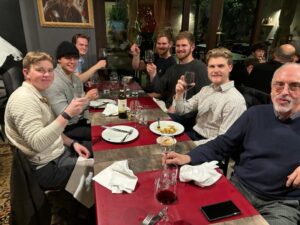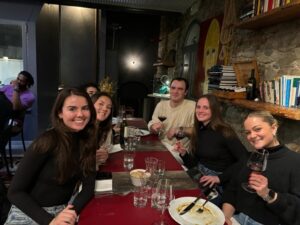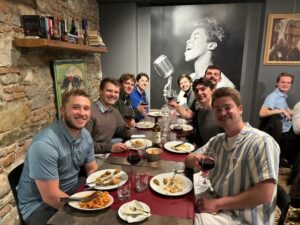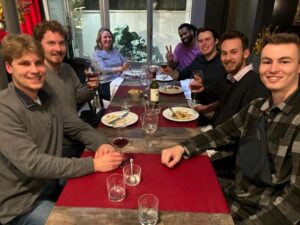Castle St. Angelo
Vatican Scavi
Today we got to visit the Vatican Scavi, which is the excavation site of Saint Peter’s burial site. This tour was done after the Castle St. Angelo tour and we coincidentally had a St. Thomas graduate as our tour guide, starting at the original location of the obelisk. This was the center of Nero’s circus where executions were done, including the crucifixion of St. Peter. As we descended beneath St. Peter’s Basilica, we learned the story of the excavation, the timing of which was when WWII was happening.
The excavation was funded by the leader of an oil company in Texas, and some notable things occurred during the excavation. There was charcoal graffiti that was interpreted to be noting that Christians were buried and that Peter was nearby. Through more excavation, bone fragments were found and analyzed only to find they belonged to two women and a cow. Through some more interpretation of graffiti, they found the exact location of where Peter’s remains were buried.
Although they had the location, there were no remains anywhere. It turns out one of the archeologists who had previously worked on the excavation took artifacts he found to his office, which was then searched, and bone fragments were found. These had dated to the first century, of a Semitic man, and every bone in the body was identified except the feet. Peter was crucified, which usually resulted in the severing of the feet at the ankle instead of prying out the nails.
This story was very powerful, and after seeing the remains of Peter we walked through where all the other previous sarcophagi were. Other notable observations included a dining table above the place where one was buried. This was because ate and celebrated after the death of someone. Death was treated as something to not fear, and that life begins after you die to be in your pure form with God.
In that same room, there was also a swastika on the ground. This is a symbol used to represent eternity as opposed to the infamy the symbol is in today due to Nazi Germany. The irony of discovering this during WWII or shortly after adds to the power of the story of finding Peter’s remains.
Additionally, it was educational to learn of the history behind the formation of the Vatican Scavi. Originally, it was a burial site for family households where hundreds of generations of family members were buried. However, in the formation of St. Peter’s Basilica, Emperor Constantine ordered that the roofs of the mausoleums be removed and filled the rooms with dirt to create a flat surface for the Basilica to be built.
This site was selected by Emperor Constantine so the remains of St. Peter would be stationed underneath the altar of the basilica to bless the Basilica and the sacraments that were performed on the altar. This was extremely tragic for the citizens of Rome because this meant entire generations of familiar burials would be lost due to the formation of the St. Peter’s Basilica. Thanks to the restoration, the ancient mausoleums can still be observed but it is bittersweet that these mausoleums were almost lost from history and buried underground for so long.
Before heading to the Vatican Scavi, we toured the Castel Sant’ Angelo on the banks of the Tiber River. The castle served as a fortress for protecting the Papacy during conflicts. Before that, it was the mausoleum of Emperor Hadrian. It has also served as a prison and is now a museum in the modern day. It is an impressive fortress, filled with traps to ward off invaders. Our tour guide pointed out the portion of the old Roman wall connected to it where there was a passage that the Pope would have been transported through between the Vatican and the fort. One room had an impressive display of mounted cannons and muskets that were used to defend the fort later in the Renaissance. The private apartments also had their fair share of intricate artwork. One of the most interesting things about this structure is it is one of the only buildings that is guarded by Angles on the Balustrades instead of Saints.
Another interesting aspect of Castel Sant’ Angelo is the material used on the walls and ceilings. Originally, the walls of Castel Sant’ Angelo were covered in yellow marble intended to invoke wealth for those entering as guests. It also had paintings displayed in the ceilings of the rooms that were meant to tell the story of what occurred during the reign of Emperor Hadrian.
One more day in Roma before traveling to Florence!
-Ethan, Adam, & Lucy
